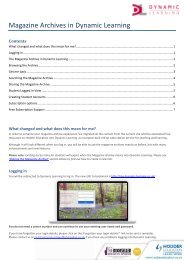GEOGRAPHY
WJEC-Eduqas-B-GCSE-Geography-sample-material
WJEC-Eduqas-B-GCSE-Geography-sample-material
Create successful ePaper yourself
Turn your PDF publications into a flip-book with our unique Google optimized e-Paper software.
THEME<br />
3<br />
Chapter 1<br />
How ecosystems function<br />
What are ecosystems?<br />
An ecosystem is a community of plants and animals and<br />
the environment in which they live. Ecosystems contain<br />
both living and non-living parts. The living part includes<br />
such things as plants, insects and birds, which depend<br />
on each other for food. Plants may also depend on<br />
insects and birds for pollination and seed dispersal. The<br />
non-living part of an ecosystem includes such things as<br />
the climate, soils and rocks. This non-living environment<br />
provides nutrients, warmth, water and shelter for the<br />
living parts of the ecosystem.<br />
Figure 2 Arctic tundra, Iceland<br />
Key<br />
Tropical rainforests<br />
Hot semi-arid grassland<br />
Subtropical evergreen forest<br />
Deciduous forest<br />
Boreal (or taiga) forest<br />
Mediterranean forest or scrub<br />
Tall-grass prairie<br />
Short-grass prairie<br />
Semi-desert<br />
Desert shrub and desert<br />
Arctic and alpine tundra<br />
Ice sheet<br />
Figure 3 Boreal (taiga) forest, Norway<br />
Figure 1 Biomes of Africa and Europe<br />
Activity<br />
1 Use Figure 1 to describe the distribution of:<br />
a) tropical rainforests<br />
b) boreal (taiga) forests.<br />
Figure 4 Tropical rainforest, Gabon<br />
16




